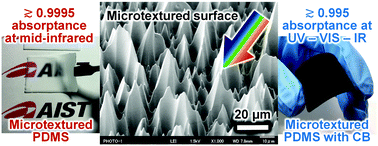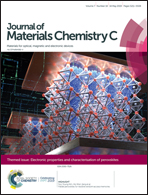Perfect blackbody sheets from nano-precision microtextured elastomers for light and thermal radiation management†
Abstract
Planar near-perfect blackbodies have wide applications ranging from dark-level reduction to light harvesting. Among them, carbon nanotube (CNT) forests have an unmatched mid-infrared blackbody performance, which is favourable for thermal radiation management. However, their inherent fragility against direct contact limits their broader use. Here we present a class of perfect blackbody sheets from elastomers outperforming CNT forests. Nano-precision micro-cavity arrays embossed on a polydimethylsiloxane (PDMS) sheet exhibit an exceptionally low reflectance of ≲0.0005 (an absorptance of ≳0.9995) over the entire mid-infrared wavelengths (6–15 μm). In addition, this sheet maintains high resilience to tape-pulling, repeated bending, and scratching. The key technology is swift (>200 MeV) heavy ion manufacturing, yielding a highly flawless template of conical micro-cavities having necessary and sufficient openings (a dozen μm) and depths (several tens of μm) to trap ultrabroadband photons: this template affords scalable replication into PDMS blackbody sheets. Notably, the just-embossed PDMS sheets are visibly transmissive, whereas pre-addition of carbon black can extend the spectral range of near-perfect absorption as wide as from ultraviolet to mid-infrared wavelengths. Our tough and flexible planar blackbodies offer versatile applications of perfect absorbers/radiators, particularly with respect to thermal infrared management.



 Please wait while we load your content...
Please wait while we load your content...